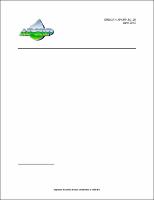Please use this identifier to cite or link to this item:
https://hdl.handle.net/11681/3898| Title: | Progress report on field surveys to identify biocontrol agents of Hydrilla verticillata in China during 2011 |
| Authors: | Zhang, Jialiang Purcell, Matthew Baoliang, Tian Ding, Jianqing |
| Keywords: | Aquatic Plant Control Research Program (U.S.) Aquatic plants--Biological control Hydrilla--Biological control China |
| Publisher: | Engineer Research and Development Center (U.S.) |
| Series/Report no.: | Technical Note (Aquatic Plant Control Research Program (U.S.)) ; no.ERDC/TN APCRP-BC-28 |
| Abstract: | INTRODUCTION: Native to Asia, Australia, Europe, and Africa, Hydrilla verticillata (L.f.) Royle (Hydrocharitaceae), or hydrilla, is a submersed aquatic macrophyte (Buckingham and Bennett 1998). Since its introduction in the early 1950s, it has become highly invasive throughout much of North America (Schmitz et al. 1991), where it hinders navigation, impacts water intake and delivery systems, limits recreational uses, out-competes native vegetation, acts as a breeding ground for mosquitoes, and destroys fish and wildlife habitats. Management of hydrilla is typically attempted with chemical control and introduction of herbivorous fish (Hanlon et al. 2000, Michel et al. 2004). Unfortunately, repetitive chemical applications can lead to the development of herbicide resistance. Resistance to the systemic herbicide, fluridone, has been reported in hydrilla populations found in Florida (Michel et al. 2004). The herbivorous fish grass carp (Ctenopharyngodon idella) can remove hydrilla effectively but it also feeds on a wide variety of native plant species. Four insect species were released for the management of hydrilla in the United States, including two weevil species and two leaf-mining flies (Buckingham and Grodowitz 2004). Only two have become established with one species of leaf-mining fly, Hydrellia pakistanae Deonier, the most widespread and damaging to hydrilla. Despite its widespread distribution, impact from H. pakistanae in the field is limited (Doyle et al. 2002, 2007; Grodowitz et al. 2003; Owens et al. 2006, 2008); therefore, more agents are required. Despite many years of worldwide overseas exploration (Balciunas et al. 2002), regions where the U.S. dioecious hydrilla biotype is native in Southern China and Southeastern Asia have yet to be thoroughly explored for potential biological control agents. The main objective of this project is to continue and expand surveys on hydrilla throughout the entire growing season in unsurveyed regions of southern China. Previous surveys in China discovered three Bagous weevils feeding on hydrilla. Bagous chinensis was found on hydrilla in Hunan Province in 2007. Host range testing determined that this weevil could develop on four other aquatic plant species, Elodea nuttallii, Egeria densa (Planch.) Casp., Vallisneria natans (Lour.) H.Hara, and Hydrocharis morsus-ranae L. (Ding et al 2009). Two Bagous species new to science were discovered in Guangxi Province (Bagous sp.1) and at Suizhou in Hubei Province (Bagous sp.2) in 2009 and 2010, respectively (Ding et al. 2011). Bagous sp.1 was not specific and developed on four non-hydrilla hosts: Lagarosiphon alternifolia (Roxb.) Druce, E. nuttallii, N. marina L., and Najas minor All. (Zhang, unpublished data). Further testing was planned but the colony perished and attempts to recollect this weevil have been unsuccessful. As yet Bagous sp.2 has not been cultured in the laboratory and no host range testing has been completed on this species. This document reports field surveys and laboratory tests of insect natural enemies on hydrilla in China and Australia from June through November 2011. |
| Description: | Technical Note |
| Gov't Doc #: | ERDC/TN APCRP-BC-28 |
| Rights: | Approved for public release; distribution is unlimited |
| URI: | http://hdl.handle.net/11681/3898 |
| Appears in Collections: | Technical Note |
Files in This Item:
| File | Description | Size | Format | |
|---|---|---|---|---|
| ERDC-TN-APCRP-BC-28.pdf | ERDC/TN APCRP-BC-28 | 925.17 kB | Adobe PDF |  View/Open |